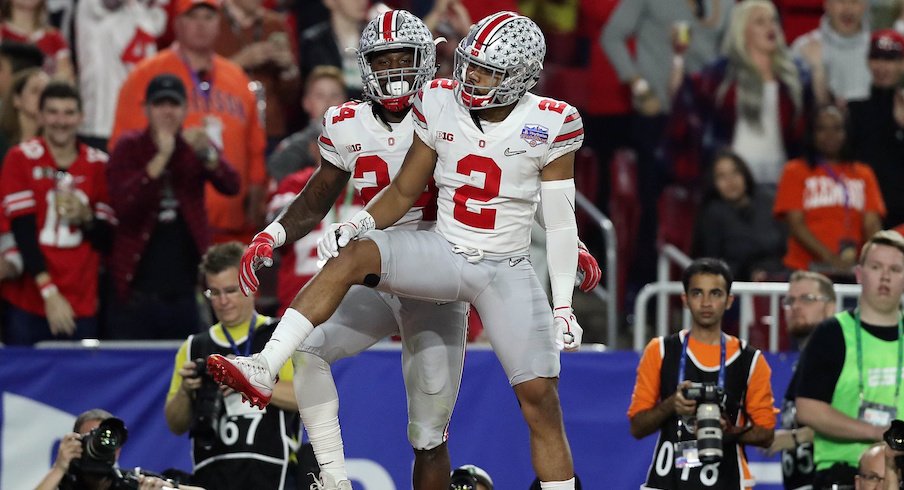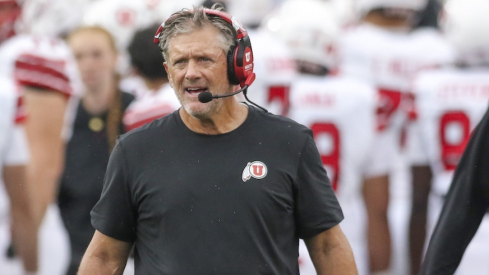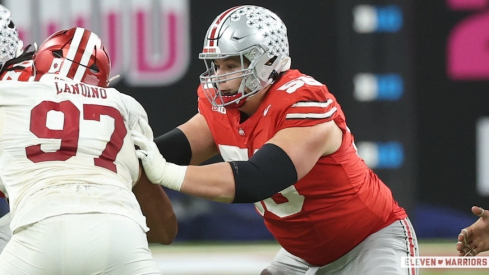As I drove down Lane Ave. two weekends ago and headed toward Ohio Stadium, I couldn't help but do a double-take. Then, I laughed out loud to myself in the car.
"Nobody in their right mind could have predicted that one year ago," I thought.
Walking down the street was a family of four — presumably — a mother, father and their two children. They appeared on their way toward the stadium for Ohio State's annual spring game. The mother and father were dressed head to toe in scarlet and gray apparel: hats, T-shirts, crazy-colored pants — the whole nine yards.
But it's what the kids had on that resonated with me most. One son was dressed in a customized scarlet Marshon Lattimore No. 2 jersey. The other son donned a white Malik Hooker No. 24.
Man, what?
Sure, Lattimore and Hooker were both studs on Ohio State's 2016 team. But seeing these two kids wearing the jerseys as I headed to cover the spring game made me think about how crazy of a journey each had — and how fast they both rose from relatively unknown to superstar in such a short amount of time.
Neither played a significant role for the Buckeyes at this time one year ago. Now, on Thursday night, both will hear their names called in the first round of the 2017 NFL Draft. And with that, we thought it'd be fun to take a look back at each's Ohio State career on the biggest night of their lives to date.
Marshon Lattimore
Marshon Lattimore committed to Ohio State on Jan. 4, 2014, one month before National Signing Day. A two-way star at Glenville High School in Cleveland and an Army All-American, Lattimore was a nationally-coveted prospect and a top-50 recruit with scholarship offers from nearly every powerhouse program in the country.
In theory, Lattimore was always supposed to be a big-time NFL prospect. That's why he was so highly regarded coming out of high school. But things in life don't always go exactly as planned and Lattimore found that out shortly after he arrived in Columbus.
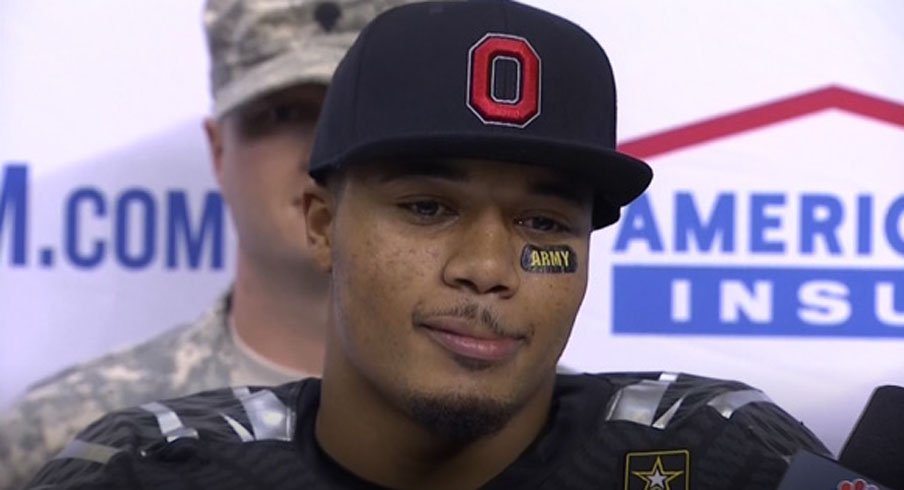
It was August of 2014 and Lattimore was in the midst of his first collegiate training camp when the injury first occurred. He missed some practice time early and then on Aug. 27 it was announced by head coach Urban Meyer that Lattimore had surgery to repair a torn hamstring. He would redshirt his freshman season so that he could fully recover and be ready to contribute to the Buckeyes in 2015.
Lattimore's first college season ended before it really got started. But as he soon found out, things were only about to get much more difficult.
The following spring, in April of 2015, Ohio State needed to find a replacement for Doran Grant at corner. Eli Apple was going to start at one spot, but the other corner position was wide open. Lattimore was still limited in spring ball due to his hamstring surgery, so he didn't have much of a shot to contend for that starting spot. And, by the end of spring, Gareon Conley won the job. Lattimore was going to have to find another way to contribute. But first, he had to get healthy.
Lattimore worked all offseason to make sure he was ready to go for his second season. He felt fit enough to play, but was he all the way back? That was the issue. Lattimore appeared in seven games for Ohio State during that 2015 season and even saw some time as the nickel corner for the Buckeyes. But he played sparingly and it was because he wasn't right. Because he didn't fully trust his injured hamstring, stress went on the opposite one and Lattimore injured that one. His second season at Ohio State: also cut short.
He surely began to wonder if he'd ever get fully healthy. If he was going to, something had to change.
Lattimore worked all offseason with Ohio State strength coach Mickey Marotti to find a way to get his body right. He got massages, he lost weight, he was put on a very specific stretching and weight room program. Lattimore said he even did yoga. Whatever it took.
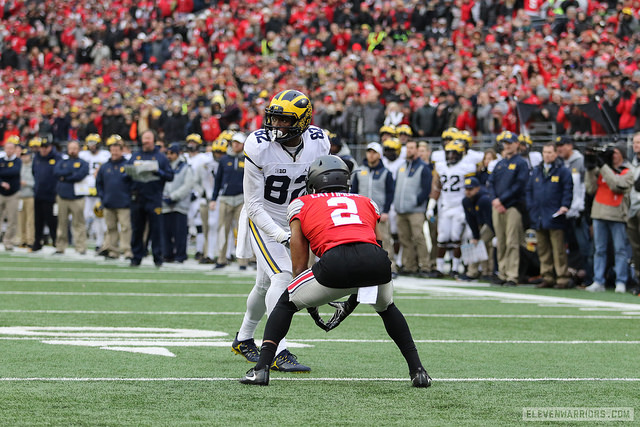
In March of 2016, during the opening weeks of spring practice, Lattimore said he felt the best he had since arriving in Columbus. Buckeyes cornerbacks coach Kerry Coombs admitted he got nervous every time Lattimore had to sprint something would happen. It didn't.
On Sept. 3, 2016, Ohio State hosted Bowling Green for its season-opener. On the first defensive series of the year, Lattimore jogged out on the field as a starting cornerback for the Buckeyes. Finally. Something that seemed like it would never happen finally did. The following week, Lattimore picked off a pair of passes against Tulsa. The second of which he returned 40 yards to the house for an Ohio State touchdown.
It turned out to be the beginning a breakout season for Lattimore, one that saw him finish with four interceptions and nine pass breakups as he and Conley made up one of the best cornerback tandems in the country. Lattimore was a first-team All-Big Ten selection.
While all of this was happening, he skyrocketed up NFL Draft boards. It seemed impossible based on how his first two seasons went, but on Jan. 11, 2017, Lattimore declared for the NFL Draft after just one season of significant playing time. He is regarded as one of the top cornerback prospects in this Draft class.
Malik Hooker
Malik Hooker's path to superstardom was a bit different but followed the same trajectory. A high school basketball phenom, Hooker opted to play football in college despite only playing for a few years at the prep level. He was a three-star recruit from New Castle, Pennsylvania, seen more as a developmental prospect than an instant-impact player like Lattimore.
Hooker had reported scholarship offers from Ohio State, Michigan, Penn State, Arizona, Pittsburgh and others, but on July 29, 2013, Hooker picked the Buckeyes.
As someone who played just two years of high school football, a redshirt was always likely during Hooker's first season at Ohio State. He could sit and learn behind the likes of Vonn Bell and Tyvis Powell during his first season on campus. He did exactly that, and the Buckeyes won the national title in 2014.
Bell and Powell both returned at safety in 2015 so if Hooker was going to make an impact it would have to be on special teams. He appeared in all 13 games Ohio State played and registered 10 tackles for the season. At this point, Hooker was still an unknown in the minds of many Buckeye fans.
But the spring of 2016 is when Hooker's name first really started being discussed. Bell and Powell both opted to leave early for the NFL so Ohio State had two open safety positions. Hooker took full advantage of the opportunity and first displayed his unique skill set during Ohio State's spring game. Hooker had a pair of interceptions and returned one of them 82 yards for a touchdown.
It was quite the foreshadow of what lied ahead.
It didn't take long for Hooker's talent to flash in games that actually counted, either. His first career interception could have quite possibly been Ohio State's best defensive play of the season. In Hooker's first career start at safety, he recorded a pair of interceptions.
And just like that, a star was born.
Hooker went on to snag interceptions in games against Tulsa, Indiana, Nebraska, Michigan and Clemson. He tallied a team-high seven picks on the season and returned three of those for touchdowns.
Hooker had a knack for making the ridiculous look simple and he turned into one of the best defensive playmakers in all of college football. Hooker's resume of game-changing plays from just one season was awfully impressive.
By year's end, he was a unanimous All-American and a first-team All-Big Ten performer. Hooker was near the top of every NFL mock draft produced. But despite saying multiple times throughout the season he intended to return to Ohio State in 2017, the opportunity was too great to pass.
On Jan. 2, 2017, Hooker declared for the NFL Draft.
It's been just over three months since those January days when Hooker and Lattimore both opted to forgo collegiate eligibility and pursue their dreams of playing professional football.
Nobody could have predicted this. Not with the way Lattimore and Hooker's careers started. Did people think they'd be NFL players when they arrived at Ohio State in 2014? Probably. That's why most come to Columbus to play college football: to make it to the next level. But both leaving college with multiple years of eligibility remaining seemed impossible based on how the first two years of their careers went.
To put it in perspective: At this time one year ago, Marshon Lattimore had five career tackles, three career pass breakups and zero interceptions. Malik Hooker had a total of 10 tackles to his name and no more stats. That was the extent of both of their collegiate resumes.
That's why the image of those two children walking down Lane Ave. in Marshon Lattimore and Malik Hooker jerseys stuck with me.
Perhaps this time next year I'll see the same two children, this time in NFL attire.
